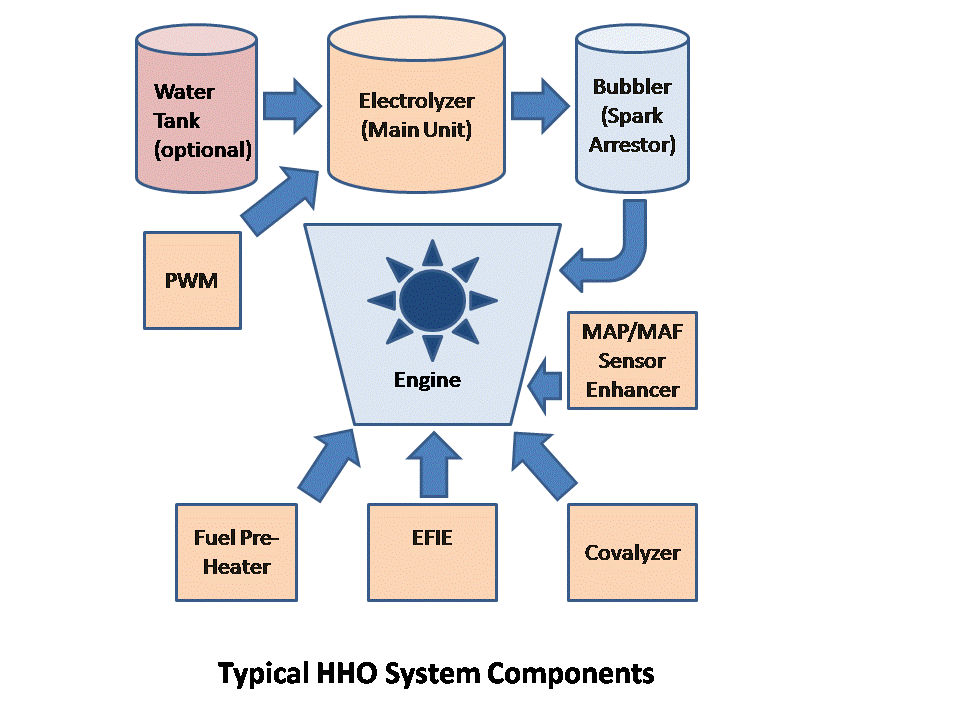|
Components of a Typical HHO SystemIn the diagram below, you can see elements that you would likely find in a so-called "complete" HHO system, or hydrogen car kit. We will discuss each of these in more detail below.
Water TankSome HHO systems incorporate a separate water tank that automatically feeds water into the electrolyzer. This is a nice convenience in that you don't have to add water to the system as often. However it is not really a problem with most systems as a little water makes a lot of HHO gas. Adding water every other time you fill up with gasoline is usually more than enough. ElectrolyzerAll HHO systems have an electrolyzer as a minimum, this is the unit that actually separates the water into hydrogen and oxygen. It may also be called a hydrogen generator, an HHO generator, hydrogen cell or some other name, but it does the same thing--it makes HHO fuel or hydroxy gas. All electrolyzers have a cathode and an anode suspended in water, and the water is usually mixed with another substance to make an electrolyte since plain water is not very conductive. Most electrolyzers use either sodium bicarbonate (common baking soda), potassium hydroxide or something similar mixed in with distilled water to form the electrolyte. Bubbler or Spark ArrestorAll HHO systems should have something between the electrolyzer and the engine to prevent flashback. This may be a bubbler, a spark arrestor, a check valve or similar device. A bubbler is simply a container through which the HHO gas from the electrolyzer is bubbled through plain water. This provides protection from flashback, and as an added advantage "dries" the HHO gas which can pull electrolyte with it as it is drawn out of the electrolyzer. PWMA PWM, or Pulse Width Modulator, is an electronic circuit which injects a pulsed DC current through the electrolyte in the electrolyzer, or hydrogen generator. This pulsed square wave DC current is said to produce a more dynamic form of hydrogen-oxygen gas called Brown's gas as discovered by Yull Brown, increasing the power output for the same current input. Fuel PreheaterAdding a fuel preheater to your fuel line helps to vaporize the gasoline more completely as it is injected into the cylinder. Most HHO systems incorporate this peripheral along with other enhancers to increase the overall synergistic effect and get the best gas mileage. EFIEThe EFIE, or Electronic Fuel Injection Enhancer, is an electronic circuit which allows the increased efficiency of the added HHO to be sustained in a fuel injected vehicle. Since nearly every vehicle built since about 1996 is fuel injected, this type of device is usually needed as part of a complete hydrogen car kit for later model vehicles in order to get the best gas mileage. Why? Because the onboard computer in your car is programmed to increase fuel injections if it detects that the mixture has become leaner (more fuel efficient) as a result of the addition of the HHO gas. It detects this by reading an increase in oxygen levels reported by oxygen sensors in the exhaust system. By adjusting for this an EFIE can enhance the system's response to save gasoline when HHO gas is added. MAP/MAF Sensor EnhancerMost cars today are equipped with either a MAP (Manifold Absolute Pressure) or MAF (Mass Air Flow) sensor. These sensors are part of the factory system which tells the onboard computer how much fuel to inject into the engine's cylinders. These can act to cancel out efficency gains produced by adding in the HHO gas to the combustion process. A MAP/MAF Sensor Enhancer adjusts the output of the sensor to sustain the gained efficiency of the HHO fuel and get the best gas mileage. CovalyzerA covalyzer is a gasoline additive which helps break down the covalent bonds of the larger, heavier gasoline molecules into lighter ones which burn more readily. This, when combined with the hydrogen and oxygen molecules creates a cleaner, more thorough burn requiring less gasoline to produce the same amount of power. Normally, gasoline is not very efficient as a fuel--much of the gasoline you put in your tank goes through your engine unburned. This is why the government requires a catalytic converter on every car--to burn the unburned gas coming out of your engine before it goes out the tailpipe and pollutes the air. So much gas just burned off as heat instead of powering your car. Wasted gas, wasted money.
|






